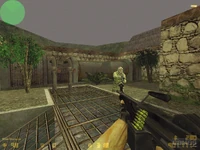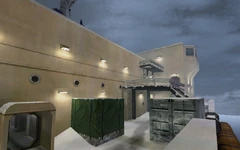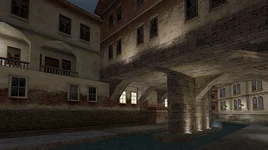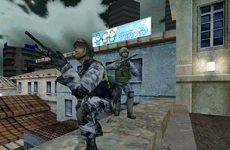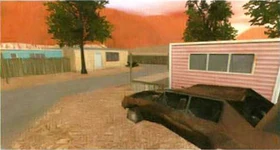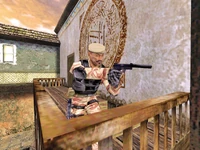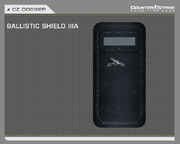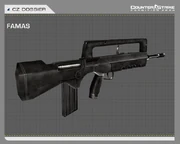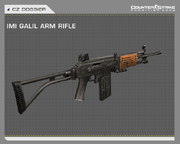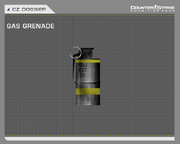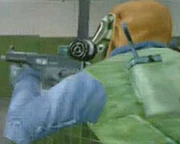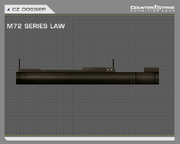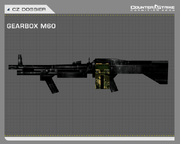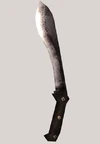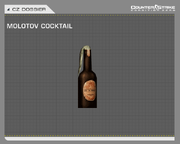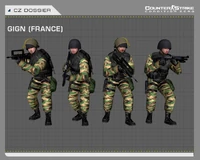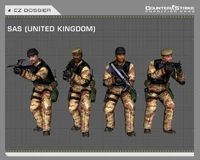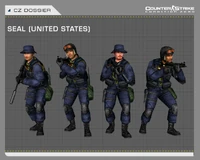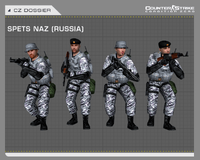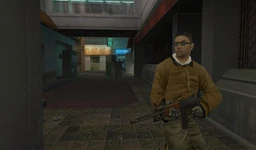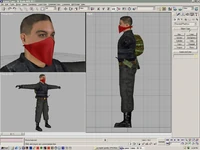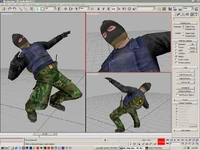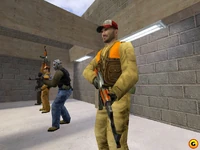The version of Counter-Strike: Condition Zero designed by Gearbox Software was the second of four major iterations of the game in the game's convoluted development history.
This iteration of the game was originally more reminiscent of the version of Condition Zero developed by Turtle Rock Studios, having an arcade-like take on the single-player experience. Later during development, the design for the single-player component was changed and it became more similar to the version designed by Ritual Entertainment which was released separately as Counter-Strike: Condition Zero Deleted Scenes.
Despite essentially getting canned, many of the concepts and assets were used in future development of both Counter-Strike and Counter-Strike: Condition Zero.
Development[]
Randy Pitchford, president of Gearbox Software, had been talking about the possibility of working on a Counter-Strike related project with Valve Software for quite a while, but other commitments had kept Gearbox from working on such a project.[1] However, in May 2001 Gearbox was just about to finish development on Half-Life: Blue Shift and wrap up work on the Playstation 2 port of Half-Life, meaning that the bandwidth needed to manage such a project was finally becoming available.[2][3] Thus, Gearbox Software decided to approach Valve about working on Counter-Strike: Condition Zero.[4]
Gearbox and Valve quickly reached an agreement whereby further primary development of Condition Zero would be handled by Gearbox.[4][5] Previous work done by Rogue Entertainment was mostly scrapped and Gearbox essentially started development from scratch.[6] Initially, development was very focused on simply creating more content, particularly maps, for the game.[7]
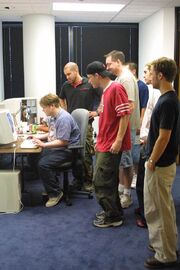
Condition Zero development team meeting, 2001
To assist in the creation of new content, several well-known designers and modders were recruited from the community. The level designing department at Gearbox was strengthened in June by the recruitment of several prominent community designers, including David Johnston, Christopher Auty and Alexander Manilov.[8][9][10] In addition, several community texture artists, such as as Mike "MikeZilla" Neumann, were also recruited.[11][10] Another community acquirement was Markus Klinge, notable for creating the original Podbot, who was hired to work on an official bot for the game.[8]
Gearbox Software's version of the game was first unveiled to the public in late August 2001.[12][13] Initially, the game was slated for a Q1 2002 release.[8] The single-player mode of the game had an arcade-like approach, inspired by console games such as Tony Hawk's Pro Skater.[14] Each map had objectives with cash rewards, and earned cash could be used for upgrading squad members and purchasing new equipment.[14] The design at this point included over 16 maps divided into four campaigns with around 10 objectives per map.[8][6][15] Other new content included 2 new factions, 8 to 10 new pieces of equipment, including new weapons, and high definition models.[15][8]

Project manager Stephen Palmer at work
By November 2001, the game was rapidly approaching alpha stages.[11] The amount of maps was specified to be between 20 and 30, divided into five different campaigns.[11][16]
In December, the game was stated to be feature complete.[17] Now the amount of maps had been locked down to 25, divided into six campaigns.[14] Most of the maps were finished by this time with only minor polishing work left to do.[17] This meant that many of the map designers recruited from the community had finished their contribution to the project by this stage and left the development team.[9][18]
On February 12, 2002 it was announced that the release of the game would be delayed until Q2 2002.[19] This delay was accounted to wanting to make the AI act as realistically as possible.[20] A factor that may also have contributed to this was the expanded design ambitions of the game, which included raising the number of objectives per map to 12.[21]
In mid-February, Gearbox Software president Randy Pitchford and vice president Brian Martel visited Europe in order to promote the game. In Europe, the game would appear at its first major media event, the Vivendi Universal Games Faire held on February 19 in Paris, France.[22][23]
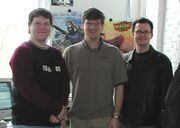
Randy Pitchford and Brian Martel with PC Games editor in Germany
Following the press event in France, Pitchford and Martel visited the offices of Vivendi Universal in Germany, where they would house previews of the game for several German gaming media.[24][25] During the last days of their trip in Europe, they would visit the offices of the German PC Games magazine, providing them an early preview build of the game.[26] PC Games would go on to release the first ever video footage of the game and a quite extensive preview based on this early build.[27][28] As an aftermath of Pitchford's and Martel's visit to Germany, other local gaming magazines, including PC Action and GameStar, would also release video coverage of the game.[29][30]
The first major media event that the game appeared at in North America was the Game Developers Conference (GDC) in March 2002.[20] At this event, the major focus was showcasing the capabilities of the bot AI.[20] Various gaming media were present at the event and GameSpot even shot a video interview with Randy Pitchford at GDC.[31][32]
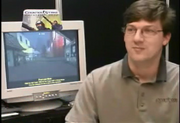
Randy Pitchford presenting the game at Game Developers Conference
Shortly after Game Developers Conference, a major change in direction occurred in the development of the game. Valve Software no longer felt like the arcade-like single-player approach was the right direction for the title and a decision was made to change the narrative portion of the game into a more traditional linear shooter.[33][7] This change was made because the narrative of the original single-player mode was not good enough.[34] In late April 2002, it was teased that this entirely new single-player experience would be revealed at E3 2002.[21]
As promised, the game was present at E3 in May 2002 and was demonstrated in NVIDIA's suite.[35] At the show, a demo was showcased which focused on pushing the new single-player experience of the game.[36] The single-player component had evolved from the arcade inspired experience to a more traditional single-player experience complete with scripted sequences.[7][2] This mode was in many ways reminiscent of Ritual Entertainment's version that was eventually released as Counter-Strike: Condition Zero Deleted Scenes.[7] Another delay was also announced, as the release of the game had been pushed to fall 2002.[37] This would end up being the last major media event that Counter-Strike: Condition Zero was presented at when Gearbox Software was still in charge of development.
In July 2002 Gearbox Software ceased development on Counter-Strike: Condition Zero and development was overtaken by Valve Software.[38] Gearbox left the project because it wanted to "[refocus] its efforts on future technology and more interesting and innovative game play".[38][39]
The decision by Gearbox Software to leave was likely fueled by displeasure following Valve's decision to change the single-player to a more linear design, an approach which Gearbox had previously called "boring"[31]. This change in single-player design also meant prolonging the development of the title and the fact that Gearbox had other lucrative projects (including PC ports of James Bond 007: Nightfire and Halo: Combat Evolved) under development could have spread their manpower too thin.
On August 1, 2002, Valve Software released an official trailer for the game based on the demo that had been showcased at E3.[40] There was likely very little actual work done on the game by Valve, as in mid-August 2002 development on the title was handed over to Ritual Entertainment who started their own iteration of the game design.[41][42]
Game modes[]
Single-player, first iteration[]
“The fundamental game design is completely different than anything we've seen in a first person action game so far - it's more akin to Tony Hawk's Pro Skater 3, than to, say, Opposing Force.”
―Randy Pitchford[43]
From the time Gearbox Software started developing the single-player mode until around March/April 2002, the main single-player mode had a very non-linear arcade inspired design which was in many ways reminiscent of the Tour of Duty game mode that was developed by Turtle Rock Studios. The designers at Gearbox Software felt that going for a standard linear design for the single-player mode would have been an easy and boring route, so they wanted to try something new and exciting and therefore went for a more arcade like approach.[31]
Originally, separate single-player campaigns were planned for both the Terrorists and Counter-Terrorists,[12] however a decision to make the campaign Counter-Terrorist only was made relatively quickly.[11] The general design of the single-player game took inspiration from console titles such as Tony Hawk's Pro Skater and Gran Turismo 3: A-Spec.[14] In the campaign, the player took the role of a Counter-Terrorist squad leader, embarking on various missions.[44]
When starting the singe player mode, a player profile had to be created first.[14] After this, the player could choose between the five different Counter-Terrorist factions.[14] Each faction had an exclusive weapon that could only be unlocked for other factions after completing the game with the faction for which the weapon was exclusive.[45] For example, completing the single-player mode with the Spetsnaz faction would unlock its exclusive weapon, the AK-47, for all the other factions,[14] and completing the game with the GIGN faction would unlock the FAMAS.[25] Each faction also had exclusive characters, with the best sniper being a SEAL Team 6 operative and the best demolitions expert a SAS operative.[46] Completing all objectives with all Counter-Terrorist squads would give the player special, undisclosed, rewards.[47]
After choosing a faction, the player would land in a virtual ready room with multiple choices.[48] These were:
- Personnel - Here a player could hire additional squad members for a maximum of four (including oneself).[14] Initially, the player couldn't afford hiring any squad members, thus the first missions were undertaken alone.[49]
Each squad member had skills which affected their performance. There were 10 different skills in total,[50] with skill levels ranging from level 1 up to level 5.[14] When hiring squad members, characters could be chosen from a pool of over 100 different possibilities with each character having an unique combination of skill levels.[51] Characters with better initial skills would cost more to hire.[4] For a cost, it was possible to train squad members at the personnel screen,[14] but only five of these ten skills were exposed to training.[50] (The improvable skills were small arms, rifle, demolitions, awareness and tactics.[20]) This meant that some bots were inherently better at certain tasks, e.g. sniping, than others.[50]
In an effort to make players feel more attached to their teammates, each squad member would also have a unique name, head model, personality and and voice.[44][12][4] - Arsenal and Load out - At the arsenal screen, one could use cash earned from completing missions for purchasing new weapons and armor to a central inventory.[14] A rifle could cost over $2000.[52] Purchased weapons, armor and other equipment were then equipped at the load out screen.[14] Each squad member could wear two firearms (primary and secondary), a kevlar, a helmet and up to three grenades.[52][25] In contrast to traditional Counter-Strike maps, there were no buy zones in the maps themselves and squad members were equipped with the arsenal specified at the load out screen.[11]
- Missions - This would take you to a mission map overview from where a mission could be started.[14][36]
Before being able to play any of the actual missions, a training mission had to be completed.[52] The game would determine the difficulty level of the campaign based on how the player performed in the training.[52]
Initially, the missions or maps were divided into four campaigns based on themes (arctic, urban, desert and jungle).[15][6] A later iteration of the game had the maps divided into six different campaigns, which were the jungles of South America, arctic Russia, urban Europe, Far East Asia, the United States and the Middle East.[50] These campaigns could be played freely in any order.[49] Each map could be played in three different modes and the objectives for the map were unique to the combination of map, mode and faction.[48][14] The game modes that the maps could be played under were the following:
- Narrative mode - This was the main story mode of the campaign, which was the only mode necessary to complete to play through the game.[28] (This probably refers to the unlocking of squad specific weapons.) When staring a map in this mode, the player would be presented with an intelligence overview providing mission instructions.[11] As the name suggests, this mode also provided the story for each mission giving players a sense of purpose and incentive to succeed.[52][4] Originally there were three objectives for each map in this mode,[14] but the amount of objectives was later raised to four.[51] Examples of objectives in this mode were:[51][14]
- Rescue hostages
- Defuse bomb
- Plant surveillance equipment[50]
- Eliminate the terrorist force
- All teammates must survive
- Win in under 3 minutes
- Endurance mode - This mode was about survival and one would play without other squad members.[51][52] The tasks in this mode were very varied, examples include:[14][51][52]
- Survive a specific amount of enemy waves for a certain amount of time
- Eliminate 8 enemies and survive for 5 minutes
- Reach the level exit
- Collect specific objects scattered around the map (e.g. suitcases with confidential information)
- Challenge mode - When playing this mode, the game was made more difficult by imposing restrictions for completing the map. These included a very short time limit, restrictions to certain weapons or being required to achieve a certain accuracy percentage.[14] Examples of such restrictions include:[51][14]
For each objective completed, the player would receive a certain amount of money (typically around $600[52]) that could be used for purchasing equipment or training squad members. Also, while the campaigns could be played in any order, unlocking the next map in a campaign required a specific amount of total earnings.[16] This usually meant completing at least two objectives per mission.[14]
The game would autosave after each completed mission, but no saving was possible while playing a mission.[44] This was because each mission would only last around four or five minutes, about as long as a traditional Counter-Strike multiplayer game.[44]
When playing the single-player missions, friendly fire would be disabled.[53] Since the game was played from the perspective of being the squad leader, death of the player would lead to a mission failure.[48] In early previews, it was stated that dead teammates would be automatically resurrected after a mission to save players from the frustration of having to load a saved game.[16] However, later previews indicate that the death of squad mates would've been permanent, making it necessary to replace them.[52]
While no specific information regarding the fate of this mode was announced, it is assumed this single-player design was partially or completely replaced with the type of single-player mode presented at E3 in May 2002.
Single-player, second iteration[]
“Our focus with Condition Zero is on creating a cinematic, story-driven experience, much like Half-Life.”
―Randy Pitchford[54]
During the E3 show in 2002, a completely new type of single-player experience was unveiled which was a lot more reminiscent of the type in Counter-Strike: Condition Zero Deleted Scenes designed by Ritual Entertainment.[21][7] This new type of single-player experience was mostly inspired by previous Gearbox Software titles such as Half-Life: Opposing Force.[2] The decision to make such a major change in the single-player design at this point in development is believed to have originated from Valve Software,[33] and was made because the narrative of the original mode wasn't good enough.[34] It is not completely clear to which extent this iteration of the single-player mode replaced the previous iteration.
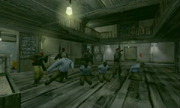
Scripted sequence providing the narrative for Junglecamp
In this updated design for the single-player game, the player was given the backstory of being a special forces soldier that is sent to various counter-terrorist units to impede terrorism.[2] This mode would provide storytelling in the forms of cutscenes and scripted sequences and was a more linear type of game.[2][7] The narrative portion of the game included more scripted sequences than any previous games by Gearbox Software.[2] All of the scenes shown in the E3 demonstration (which was later released as the official trailer[40]) were scenes that would actually occur when playing the game.[34]
The missions for this mode were created by editing the maps that had been previously created for the old arcade-like single-player experience.[7] For example, Dahab was modified to have a cutscene where a helicopter was shot down, providing the narrative for the task to extract the captured pilots.[55] Pitchford stated that there would be six chapters in the game with three or four missions each,[2] suggesting that most of the already existing maps were to be converted to this new format.
Skirmish[]
A skirmish mode, which was a traditional multiplayer game against bots, was also available.[56]
Cooperative play[]
The game was to feature cooperative play support where the narrative portion of the could be completed together with friends.[57] All the single-player missions could be played cooperatively.[58] While the single-player missions were designed for four player squads, Pitchford mentioned that there were no technical hindrances for cooperative games supporting as many players as traditional multiplayer games.[58]
Multiplayer[]
“In multiplayer, Condition Zero IS Counter-Strike.”
―Randy Pitchford[2]
In Gearbox Software's design of Counter-Strike: Condition Zero the multiplayer component was to be compatible with the original Counter-Strike in order to not separate the community.[57] A patch was to be released for the original Counter-Strike to add cross compatibility.[59]
Much of the new content would therefore be released for the original Counter-Strike free of charge. This included all of the new maps and some of the new weapons.[51] The weapons were to be released gradually, at a rate of about 2 weapons per update, to ensure that the weapons would be properly balanced.[36][60] Some of the weapons, including the LAW, would likely not have been released to multiplayer.[61]
However, the bots and the higher quality player models would stay exclusive to owners of Condition Zero.[51][62] Owners of Condition Zero were to be able to freely customize their player model head and skin from the available choices when choosing their faction.[63]
Gearbox Software had close ties with the competitive scene, particularly with the Cyberathlete Professional League (CPL). Randy Pitchford was on the board of CPL and Mike Wardwell was the commissioner of the CPL, giving Gearbox a clear understanding of what was needed to accommodate professional competition.[17][11] Perhaps due to this, the CPL announced plans to have Condition Zero featured at their summer 2002 championships.[64] However, due to the game being delayed, Condition Zero would not end up being featured at the event and the original Counter-Strike took its place.[65]
Scenarios[]
All the popular scenarios (hostage rescue, bomb defusal and assassination) from the original Counter-Strike were going to return in the version of Counter-Strike: Condition Zero designed by Gearbox Software.[8] New maps were designed for each of these scenarios,[28] though the only assassination map designed for this iteration of the game ended up getting cut when Gearbox Software was still developing the game.[7]
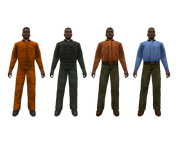
New hostage variants
While the concept of these scenarios stayed the same, they were slightly updated. For the hostage rescue scenario, new hostage models were created that improved the polygon count to around 1000 polygons. Left-over models suggest that there were at least four different theme dependent skins (arctic, desert, European and jungle) with four different heads each.[66] The head variations suggest that in a regular hostage rescue scenario with four hostages, each hostage would have had a slightly different look. It is likely that a new VIP model was created for the assassination scenario to complement the new player and hostage models, but such a model was never shown to the public.
The introduction of one or two new multiplayer scenario types was also mentioned.[58] One potential candidate for these new scenario types was a scenario where a player had to reach a certain area and perform an action (such as demolishing a computer). This would have differed from the bomb defusal scenario at least in the regard that no special equipment was needed allowing any player to function as the key player.[4] Another candidate was a scenario where a team started off without weapons and had to escape from an area.[4] It is not known how exactly this would have differed from the abandoned escape scenario. As all known new maps were created for one of the three "classic" scenarios, it is possible that these new scenarios would've functioned as an alternate or secondary scenario for select maps.
Maps[]
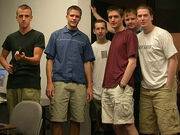
Community mapping team at Gearbox Software
Several prominent community mappers, many known for their previous work on Counter-Strike, were recruited by Gearbox Software to help out in map design during the development of Counter-Strike: Condition Zero.[8] These people were David Johnston, Christopher Auty, Erik Doescher, Alexander Manilov, Matt Coombe, Nick Coombe, Dan Haigh, Marc Schröder and Alex Gingell.[8] Mike Wardwell was the lead level designer on the title.[11]
Additionally, artists Mike Neumann, Ted Anderson and Chris Greenhaw were recruited to help provide textures for the maps.[67] To ensure an authentic look, Gearbox Software sent teams to five of the six campaign locations to take several gigabytes of photos to be used as texture source (texture sources for the Middle East were sourced from CNN).[56]
The community mappers were originally recruited on a contractual basis for the design of a few maps.[68] This allowed them to perform their work off site, making only a few visits to the offices of Gearbox Software during development.[10] Many of the community mappers would finish their contribution toward the project by the end of 2001.[9][18][69] However, at least Christopher Auty and Erik Doescher would end up staying at Gearbox Software for a longer time.[10][68]
Originally, there were plans to have over 16 maps divided into four campaigns based on themes (arctic, urban, desert and jungle).[8][15][6] By late October 2001, the amount of maps had been raised to 21 split into five campaigns (the urban campaign had been split into two: a Europe and North America campaign).[4][11] Finally in December, the number of maps was raised to 25, which were divided into six campaigns of four maps (plus the training map).[14] The new sixth campaign was the Asian campaign.[14] The final rooster of campaigns was thus the jungles of South America, arctic Russia, urban Europe, Far East Asia, the United States and the Middle East.[14][50] There exists some ambiguity in the amount of maps planned to be included in the final game, with various number ranging between 20 and 25 being reported.[21][25][24] It is likely that the final amount had not yet been determined.
All maps (except the training map[43]) would be playable in single-player, cooperative play and multiplayer.[58][37]
List of maps[]
The listing below includes all known maps that were present in the game at some point during development of the game by Gearbox Software. However, some of these maps were cut when Gearbox was still developing the game.[7]
Weapons and equipment[]
The design featured 12 new pieces of equipment of which 8 were new weapons. New weapons were decided for the game based on their appropriateness for characters and locations or because they created new solutions for tactical problems in the game.[2] However, some of the weapons were included simply because Gearbox felt they were "just plain cool".[2]
Notably, the high-definition content included in the design of Counter-Strike: Condition Zero by Gearbox Software would not include upgraded weapon models and the original models from Counter-Strike would still be used.[58]
| Name: | Ammo Belt | |
| Type: | Equipment | |
| Side: | Counter-Terrorists | |
| Price: | Unknown | |
| The ammunition belt was a single-player exclusive item.[70] It would double the amount of extra clips/magazines that the player could carry.[71] | ||
| Name: | Ballistic Shield IIIA | |
| Type: | Equipment | |
| Side: | Counter-Terrorists | |
| Price: | $1000[72] | |
| This Counter-Terrorist exclusive equipment had the ability to block any fire expect for a LAW rocket.[49] Due to balance reasons, the shield could only be used together with the Five-SeveN.[73] | ||
| Name: | FAMAS | |
| Type: | Rifle | |
| Side: | Counter-Terrorists | |
| Price: | $2500[52] | |
| As a Counter-Terrorist exclusive rifle, the FAMAS sported both good accuracy and rate of fire.[74] It could be fired in either full automatic or a 3 round burst mode.[58] The developers at Gearbox Software felt that the French FAMAS had to be added since the French special forces, the GIGN, were already in the game.[75] | ||
| Name: | Flare | |
| Type: | Grenade | |
| Side: | Unknown | |
| Price: | Unknown | |
| A weapon likely inherited from Rogue Entertainment's iteration of the game, the flare would illuminate dark areas by emitting red light.[58][24] It could either be used to illuminate popular dark camping spots to prevent their use down the line, or it could also be used to spot enemies hiding in darker areas since it could be thrown and bounced off walls.[58] This piece of equipment was being considered for removal when Gearbox was still developing the title.[71] | ||
| Name: | IMI Galil ARM Rifle | |
| Type: | Rifle | |
| Side: | Terrorists | |
| Price: | $2700[52] | |
| This terrorist exclusive rifle could hold 32 rounds and was between a sub machine gun and the AK-47 in its efficiency.[49] However, both it's rate of fire and damage were worse than that of the FAMAS.[49] The inclusion of this weapon was inspired by the film The Way of the Gun.[56] | ||
| Name: | Gas Grenade | |
| Type: | Grenade | |
| Side: | Counter-Terrorists | |
| Price: | $400 | |
| The gas grenade was a Counter-Terrorist exclusive weapon with a similar function as the Molotov cocktail. It could be used to block pathways as the greenish gas it released would cause several effects including high damage.[59][8] Another effect of the gas grenade included blurring the affected players vision and reducing accuracy, an effect which would last for a few moments even after leaving the gas cloud.[59] It would also cause the affected player to cough, alerting nearby players to ones position.[76] The gas would dissipate in about 30 seconds.[52] Perhaps due to its quite severe effects, a gas mask could be purchased to make oneself immune to it.[58] | ||
| Name: | Gas Mask | |
| Type: | Equipment | |
| Side: | Both | |
| Price: | Unknown | |
| The gas mask was used to protect oneself against the effects of gas grenades.[58] Purchasing a gas mask would make it visible on the player model.[59] In addition, an icon would be present on the interface to remind the player of the fact that the mask was active.[48] | ||
| Name: | M72 LAW | |
| Type: | Grenade | |
| Side: | Both | |
| Price: | $1200[52] | |
| Originally planned as a terrorist exclusive weapon but subsequently made available for both factions, this single shot weapon functioned more like a grenade than a rocket launcher.[58][59] Purchasing this weapon would make the player unable to buy any other grenades.[58] It would make a recognizable noise when being fired, giving players time to seek cover.[52] Inclusion of the LAW was inspired by the film Black Hawk Down.[45] | ||
| Name: | Gearbox M60 | |
| Type: | Machine gun | |
| Side: | Terrorists | |
| Price: | $5000[52] | |
| This terrorist exclusive machine gun would get more accurate the longer one fired with it.[59][49] Additionally, it could hold up to 100 bullets.[59] This weapon was likely inherited from Rogue Entertainment's iteration of the game design. | ||
| Name: | Machete | |
| Type: | Melee weapon | |
| Side: | Terrorists | |
| Price: | Unknown | |
| This melee weapon was terrorist exclusive and had to be bought separately.[76] It inflicted higher damage and had a longer reach than a regular knife.[61] | ||
| Name: | Molotov Cocktail | |
| Type: | Grenade | |
| Side: | Terrorists | |
| Price: | Unknown | |
| These terrorist exclusive grenade like weapons could be used to temporarily block paths.[49] They had to be lit before being thrown, which was a relatively slow process.[62][71] Dying while igniting a Molotov would cause the Molotov to explode on the ground.[49] A thrown Molotov would explode on impact, leaving behind a trail of flames that burned for around 10 seconds.[76] Direct impact with the Molotov cocktail itself did little damage, however the resulting fire could seriously damage players.[58] | ||
| Name: | Suicide Belt | |
| Type: | Equipment | |
| Side: | Terrorists | |
| Price: | Unknown | |
| This terrorist exclusive weapon would cause a huge explosion when used, damaging everyone around them. It was present very early in design and likely inherited from Rogue Entertainment's design iteration, but it was quickly removed due to concerns with griefers blowing up their team at spawn.[62] | ||
Factions and player models[]
Gearbox Software's iteration of the game kept the Russian Spetsnaz Counter-Terrorist faction which originated from Rogue Entertainment's design and additionally introduced a new American Militia Extremist Terrorist faction.[12]
In addition to the new factions, each faction model could have four different heads.[8] Further variation was also achieved by introducing alternate skins for the character classes. Counter-Terrorists would wear mission appropriate camouflage in the form of arctic, jungle, desert and urban uniforms.[11] The urban camouflage was based on the real-world design for each unit.[4] The Terrorists wouldn't don camouflage, but would wear environment appropriate clothing and you wouldn't "have guys running around in short sleeve shirts in the Arctic".[14]
With 10 different factions having 4 unique head models and 4 unique skins/uniforms, a total of 160 different model combinations were possible.[77] Due to this huge amount of variation Gearbox quickly found themselves short of people to model. To overcome this issue, they started pulling in random visitors who they then photographed and motion captured to use as bases for their models.[54][56] This included people from package delivery companies such as UPS and FedEx.[2]
The new player models also offered an improvement in visual quality in addition to visual variation. In the original Counter-Strike, player models had around 750 polygons each while the new models created by Gearbox sported around 1250 polygons.[8] There was also going to be lip-syncing for the models when players used radio commands.[8] All the player models were the work of Matt VanDolen.[11]
Music and sound effects[]
Each campaign in the game would have an unique music score composed by Chris Jensen, who had previously scored the music for e.g. Half-Life: Opposing Force.[62] All sound effects were also to be enhanced to 16 bit sound quality.[16]
Interface[]
The game main menu front end had been completely rethought and would be drawn by the game engine itself.[56] This meant that the menu would no longer be fixed at 640x480 and it would be possible to use any resolution in the main menu.[78]
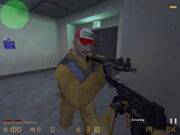
Interface with location and accuracy indicators
All the in game menus (e.g. the buy menu) as well as the mission load out and mission selection screens were designed utilizing the new VGUI 2.0 technology developed by Valve.[36] The introduction of several new weapons also saw some changes to the buy menu interface. A separate menu for grenades was added, and the ability to repurchase the same weapons one bought in the previous round was also added.[8]
The game interface also saw the addition of a text map location indicator in the lower-left corner of the screen. This was partly introduced due to the expanded size of the maps present in Condition Zero.[79] Additionally, an accuracy indicator was also seen on the interface in some screenshots. This was probably added to make it easier to complete the challenge mode tasks which required the player to achieve a certain level of accuracy.
Technology[]
While still utilizing the original Half-Life engine, various enhancements were made to the technology in order to ensure a more current look for the game.
Bots[]
The bot technology was perhaps the single most important piece that the game centered on. Gearbox Software recruited Markus Klinge, the creator of PODBot, after testing all unofficial bots in an effort to find the best one.[8] Klinge now got access to the engine internals and could work together with the game engineers to improve the way the bots functioned.[80][31]
The bots still relied on waypoints to guide them around, much like the original PODBot.[58] Also, waypoints had to be manually created for each map,[48] unlike the final bot by Turtle Rock Studios which has the ability to automatically learn new maps. However, the bot had the ability to learn from successes and failures and would revisit or avoid certain areas depending on previous outcomes.[31] This functioned by having the bot update the waypoint file itself depending on the outcome.[20] It was possible to turn this learning feature off.[81]
There were also several possibilities for modifying the behavior of bots. One could manually edit the map specific waypoints to tweak the way in which the AI/bot would play the map.[58] In addition, the bots had numerical values for several skill levels which could be modified from a simple text file.[20] Technically, these values ranged from 0-10 with floats giving actual possible skill levels from 0 to 99.[56] However, bots with skill levels over 5 (or 50) would be "doing head shots through doors", making it necessary to clamp the skill levels to 5 for the single-player mode.[56] There were 10 different skills in total, five of which were revealed:[20][50]
- Small Arms
- Rifle - Affected reloading speed and accuracy of rifles[11]
- Demolitions - Ability to defuse bombs and utilize explosives (grenades)[11]
- Awareness - Ability to react to surroundings, such as responding to the sound of gun fire[50]
- Tactics - Ability to communicate with other squad members and move as a unit[50]
Controlling the bots was to be kept simple since the people at Gearbox Software felt that complicated control systems were just a substitute for bad AI.[75] Originally, a player could control bots in their squad by using radio commands.[77] This was a somewhat extended version of the traditional radio command system to allow for better squad control.[4] However, a later iteration aimed to remove the need for radio commands by making the bots react better to their surroundings and actions by the player.[20] This included things like responding to fire and mimicking the approach the player was making to areas.[20]
For naming the bots, the nicknames of various people who were involved in the development of the title were used.
The bots had managed to fool a freelance gaming journalist into thinking he was playing against actual humans, a testament to the quality of the bot.[56]
Visual effects[]
Improvements in how models were handled in the engine included the addition of support for alpha blended textures.[1]
A level of detail system was also added in Counter-Strike: Condition Zero. There were about five different levels of detail for regular models and three levels of detail for special effects.[56] The detail level of models would change dynamically depending on the performance of the machine, thus ensuring compatibility with older machines.[56]
Another new addition was a material system. It made material specific gibs possible meaning that shooting a wooden board would result in wood gibs and sound effects.[8] In order to utilize the system to its full potential, several different types of the same material were modeled into the game, including three different types of glass.[49]
Finally, a weather system was also added into the game making it possible to have levels with rain or snow.[4] This was a purely visual feature that had no effect on gameplay.[4]
Mapping, modding and editing tools[]
New features for mapping included the possibility of placing world models into the void area, creating an illusion of a bigger playable area.[82] This could also be used to make the sky seem like more than just a background image.[59] Another new mapping entity was a particle emitter that could be used to make effects like smoke coming out of chimneys.[82][78] The location indicator that had been added to the interface was implemented by introducing location entities that were present in the map file.[82]
Custom weapon models would not have been allowed in the game. This decision was made in an effort to thwart cheating where people would replace the models with "spiked models" making it considerably easier to detect other players.[59] Curiously, custom player models would still be allowed.[59]
A new SDK was planned to be released coinciding with the release of Counter-Strike: Condition Zero.[59] This was going to enable the community to create custom single-player content for the game.[83] The SDK would include an updated version of Worldcraft (or possibly Gearcraft,[11] the Gearbox custom version of Worldcraft) and various other tools that Gearbox Software had developed during the design of Condition Zero.[48][59] These other tools included updated versions of the map compiling tools by Zoner, which provided better quality lightning and texturing.[8] In addition, the new and improved player models would be included with the SDK to facilitate using them as base for other mods.[83]
Content delivery and anti-cheat[]
The game was to be released both at retail and through the Steam client by Valve Software.[21] Besides allowing quick content updates, a major reason for its usage was the anti-cheat technology provided by it.[51] The original functioning principle of the anti-cheating technology was the verification of game files prior to launch and the ability to push quick updates in an effort to keep ahead of cheaters.[36]
Legacy[]
Despite essentially getting canned when Ritual Entertainment took over development on the title, many of the ideas would end up being used in future development of Counter-Strike, Counter-Strike: Condition Zero and Counter-Strike (Xbox):
- The concept for the first iteration of the single-player design by Gearbox was used as the base for the Tour of Duty single-player mode by Turtle Rock Studios, while the second iteration was used as the base for Deleted Scenes by Ritual Entertainment.
- Some of the multiplayer maps made their way into the final release of Counter-Strike: Condition Zero. Other maps were used as starting geometry for the single-player missions produced by Ritual Entertainment.
- The Tactical Shield, Galil and FAMAS made their way into regular Counter-Strike and Counter-Strike: Condition Zero. In addition, the Machete, M72 LAW, Suicide Belt and the M60 made their way into Ritual's single-player experience.
- Both Spetsnaz and Midwest Militia were included in the final version of Condition Zero.
- A location indicator was inherited to the design of the game by Ritual Entertainment, though it functioned in a quite different way.
- While the bots by Klinge were scrapped, the idea lived on in both Ritual's and Turtle Rock's designs.
- The weather system was eventually implemented into regular Counter-Strike and Counter-Strike: Condition Zero.
- Support for alpha blended textures was also eventually implemented into regular Counter-Strike and Counter-Strike: Condition Zero.
- The material system was inherited into Ritual's version of Condition Zero.
- The Bot control idea eventually made it into Counter-Strike: Global Offensive.
References
- ↑ 1.0 1.1 Games Domain - Counter-Strike: Condition Zero - Pipeline Preview. Archived from the original on 2001-12-04.
- ↑ 2.00 2.01 2.02 2.03 2.04 2.05 2.06 2.07 2.08 2.09 2.10 Action Vault - Counter-Strike: Condition Zero Interview. Archived from the original on 2002-08-02.
- ↑ GameSpot - E3 2001: Half-Life: Blue Shift goes gold
- ↑ 4.00 4.01 4.02 4.03 4.04 4.05 4.06 4.07 4.08 4.09 4.10 4.11 PC Zone - Issue 109 (2001-12) Dennis Publishing Ltd.
- ↑ MGON - Randy Pitchford Interview. Archived from the original on 2001-12-14.
- ↑ 6.0 6.1 6.2 6.3 Gamehelper.com - Condition Zero Int.. Archived from the original on 2003-01-18.
- ↑ 7.0 7.1 7.2 7.3 7.4 7.5 7.6 7.7 7.8 Counter-Strike: Condition Zero Information Vault - Josh Jeffcoat Interview
- ↑ 8.00 8.01 8.02 8.03 8.04 8.05 8.06 8.07 8.08 8.09 8.10 8.11 8.12 8.13 8.14 8.15 8.16 GameSpy.com - Preview: Counter-Strike: Condition Zero (PC). Archived from the original on 2001-12-04.
- ↑ 9.0 9.1 9.2 LinkedIn | Alexander Manilov
- ↑ 10.0 10.1 10.2 10.3 CS-Nation - barney (aka n@rby) interview. Archived from the original on 2002-12-18.
- ↑ 11.00 11.01 11.02 11.03 11.04 11.05 11.06 11.07 11.08 11.09 11.10 11.11 11.12 11.13 The Adrenaline Vault | Featured Game : Condition Zero. Archived from the original on 2003-12-14.
- ↑ 12.0 12.1 12.2 12.3 pc.ign.com: Counter-Strike: Condition Zero Interview. Archived from the original on 2001-12-01.
- ↑ Shacknews | Gearbox: Condition Zero
- ↑ 14.00 14.01 14.02 14.03 14.04 14.05 14.06 14.07 14.08 14.09 14.10 14.11 14.12 14.13 14.14 14.15 14.16 14.17 14.18 14.19 14.20 14.21 14.22 14.23 GameSpy.com - Preview: Counter-Strike: Condition Zero Revisited. Archived from the original on 2002-02-01.
- ↑ 15.0 15.1 15.2 15.3 HomeLan Fed : General News : Counter-Strike: Condition Zero Interview. Archived from the original on 2001-10-08.
- ↑ 16.0 16.1 16.2 16.3 Intelgamer.com - Counter-Strike: Condition Zero Interview. Archived from the original on 2002-01-27.
- ↑ 17.0 17.1 17.2 17.3 Halflife.nu - CS:Condition Zero interview. Archived from the original on 2002-01-05.
- ↑ 18.0 18.1 LinkedIn | Nick Coombe
- ↑ Press Release - Counter-Strike: Condition Zero To Ship Worldwide Q2 2002
- ↑ 20.0 20.1 20.2 20.3 20.4 20.5 20.6 20.7 20.8 Gamehelper.com - GDC | At Ground Zero with Condition Zero. Archived from the original on 2002-06-22.
- ↑ 21.0 21.1 21.2 21.3 21.4 The Adrenaline Vault | News | Condition Zero Update. Archived from the original on 2002-06-03.
- ↑ 4Players.de - Special: Vivendi Universal Games Faire 2002
- ↑ Press Reelase - Universal Interactive launches Monster Force, a new multi-player handheld game adventure. Archived from the original on 2002-06-06.
- ↑ 24.0 24.1 24.2 4Players.de - Interview - Randy Pitchford
- ↑ 25.0 25.1 25.2 25.3 Gameswelt - Counter-Strike: Condition Zero - First Look
- ↑ PC Games - Counter-Strike: Condition Zero - Entwicklerbesuch
- ↑ PC Games - Es ist da: Das Video zu Counter-Strike: Condition Zero
- ↑ 28.0 28.1 28.2 PC Games 04/02 (2002) Computec Media GmbH.
- ↑ PC Action 04/02 - Counter-Strike: Condition Zero. (2002). [video]. Computec Media GmbH.
- ↑ GameStar 04/02 - Counter-Strike: Condition Zero - Preview-Video. (2002). [video]. IDG Entertainment Verlag GmbH.
- ↑ 31.0 31.1 31.2 31.3 31.4 31.5 GameSpot - Counter-Strike: Condition Zero Video Interview. (2002). [video]. CNET Networks, Inc.
- ↑ GameSpot: PC Media Index: Counter-Strike: Condition Zero. Archived from the original on 2002-03-29.
- ↑ 33.0 33.1 Shacknews Article - Counter-Strike: Condition Zero (Ritual Entertainment). Archived from the original on 2003-01-27.
- ↑ 34.0 34.1 34.2 PC Zone - Issue 118 (2002-08) Dennis Publishing Ltd. - Read via Cool Guys Krew A Great Site for Cs stuff. Archived from the original on 2002-09-26.
- ↑ Press Release - NVIDIA and Valve Demonstrate Counter-Strike: Condition Zero at E3 2002. Archived from the original on 2002-06-09.
- ↑ 36.0 36.1 36.2 36.3 36.4 Gamehelper.com - E3 | Condition Zero Update. Archived from the original on 2002-08-16.
- ↑ 37.0 37.1 Action Vault - Counter-Strike: Condition Zero Intelligence Report. Archived from the original on 2002-08-02.
- ↑ 38.0 38.1 .plan File for Randy Pitchford
- ↑ Ritualistic Forums - View Single Post (by BrushBaron) - Re: To: Any Ritual team members Re: Thanks
- ↑ 40.0 40.1 CS-Nation - new cs: cz movie. Archived from the original on 2003-04-23.
- ↑ GameSpy.com - Preview - Counter-Strike: Condition Zero (PC). Archived from the original on 2002-12-21.
- ↑ Ritualistic Forums - View Single Post (by kanaeda) - Re: wow
- ↑ 43.0 43.1 Lone Gamers: Condition Zero. Archived from the original on 2002-08-11.
- ↑ 44.0 44.1 44.2 44.3 CG Online - Counter-Strike: Condition Zero Preview. Archived from the original on 2002-02-10.
- ↑ 45.0 45.1 Ferrago.co.uk - Counter-Strike: Condition Zero Preview. Archived from the original on 2002-04-08.
- ↑ Player Of Games - Condition Zero interview with Randy Pitchford director of Gearbox software. Archived from the original on 2002-04-29.
- ↑ Zero-Tolerance - Randy Pitchford Interview. Archived from the original on 2002-02-05.
- ↑ 48.0 48.1 48.2 48.3 48.4 48.5 Tiscali Games | Counter-Strike: Condition Zero - interview. Archived from the original on 2002-05-22.
- ↑ 49.0 49.1 49.2 49.3 49.4 49.5 49.6 49.7 49.8 FiringSquad: GDC 2002 - CS Condition Zero. Archived from the original on 2002-08-23.
- ↑ 50.0 50.1 50.2 50.3 50.4 50.5 50.6 50.7 50.8 PC Zone Preview: Counter-Strike: Condition Zero. Archived from the original on 2007-07-01.
- ↑ 51.0 51.1 51.2 51.3 51.4 51.5 51.6 51.7 51.8 Counter-Strike: Condition Zero Preview - Counter-Strike: Condition Zero Previews for PC at GameSpot. Archived from the original on 2003-06-22.
- ↑ 52.00 52.01 52.02 52.03 52.04 52.05 52.06 52.07 52.08 52.09 52.10 52.11 52.12 52.13 52.14 GameStar 04/02 (2002) IDG Entertainment Verlag GmbH.
- ↑ PC Games - Counter-Strike: Condition Zero - die wichtigsten Infos
- ↑ 54.0 54.1 Games Domain - Counter-Strike: Condition Zero hands-on - Pipeline Preview. Archived from the original on 2002-12-22.
- ↑ GameSpy.com - E3 2002 Coverage - Counter-Strike: Condition Zero. Archived from the original on 2002-08-10.
- ↑ 56.0 56.1 56.2 56.3 56.4 56.5 56.6 56.7 56.8 56.9 IGN PC Games: Counter-Strike: Condition Zero Preview. Archived from the original on 2002-06-01.
- ↑ 57.0 57.1 Ferrago.co.uk | PC Games: Interviews | Counterstrike: Condition Zero - Randy Pitchford. Archived from the original on 2002-11-05.
- ↑ 58.00 58.01 58.02 58.03 58.04 58.05 58.06 58.07 58.08 58.09 58.10 58.11 58.12 58.13 58.14 CS-Nation - randy pitchford interview. Archived from the original on 2002-02-22.
- ↑ 59.00 59.01 59.02 59.03 59.04 59.05 59.06 59.07 59.08 59.09 59.10 59.11 CS Central - CS: CZ Preview. Archived from the original on 2002-03-10.
- ↑ GameSpot - E3 2002: Counter-Strike: Condition Zero impressions
- ↑ 61.0 61.1 CS-Nation - condition zero weapon info. Archived from the original on 2002-10-16.
- ↑ 62.0 62.1 62.2 62.3 Gameplanet - Counter-Strike: Condition Zero Live Chat. Archived from the original on 2001-12-25.
- ↑ XGR.COM - The Net's FIRST 24/7 Radio Station For Gamers : The Randy Pitchford Interview. Archived from the original on 2002-08-27.
- ↑ Press Release - CPL Announces Summer Championship Event. Archived from the original on 2002-06-06.
- ↑ The Cyberathlete Professional League Summer Championship 2002 Event. Archived from the original on 2002-06-04.
- ↑ Counter-Strike: Condition Zero Deleted Scenes - Presence of props/deadguy_arctic.mdl, props/deadguy_desert.mdl, props/deadguy_euro.mdl and props/deadguy_jungle.mdl
- ↑ CS-Nation - condition zero multiplayer. Archived from the original on 2002-06-05.
- ↑ 68.0 68.1 thewall.de Editing Forum - [Biografie] Gute Brushes, schlechte Brushes...
- ↑ Half Life Italia - Level design: eight experts confrontation - Nick “Crinity” Coombe. Archived from the original on 2003-04-13.
- ↑ CS-Nation - condition zero equipment info. Archived from the original on 2002-10-08.
- ↑ 71.0 71.1 71.2 PC Games - Counter-Strike: Condition Zero - die neuen Waffen
- ↑ Frontline Message Board - Counter-Strike: Condition Zero Preview
- ↑ Gearbox Software Forums - Ballistic Shield question. Archived from the original on 2002-11-04.
- ↑ GameSpy.com - The Most Wanted Games of 2002. Archived from the original on 2004-03-03.
- ↑ 75.0 75.1 PC Games 05/02 - Vorschau: Counter-Strike: Condition Zero. (2002). [video]. Computec Media GmbH.
- ↑ 76.0 76.1 76.2 Shacknews Article - Counter-Strike: Condition Zero. Archived from the original on 2002-06-04.
- ↑ 77.0 77.1 counter-strike[uk] - Counter-Strike: Condition Zero Preview. Archived from the original on 2001-11-24.
- ↑ 78.0 78.1 CS-Nation - condition zero technology. Archived from the original on 2002-10-08.
- ↑ CS-Nation - condition zero single-player. Archived from the original on 2002-06-05.
- ↑ ComputerAndVideoGames.com - Feature: Shifting up a gear: Randy Pitchford Interview. Archived from the original on 2007-03-28.
- ↑ gamigo.de - CS: Condition Zero - Angespielt. Archived from the original on 2002-04-10.
- ↑ 82.0 82.1 82.2 Gearbox Software Forums - Designing Levels For CZ. Archived from the original on 2002-08-21.
- ↑ 83.0 83.1 ComputerAndVideoGames.com - PC Interview: Interview: Still-life? Not on your nelly. Archived from the original on 2007-10-18.
| |||||||||

